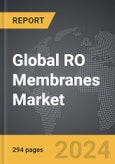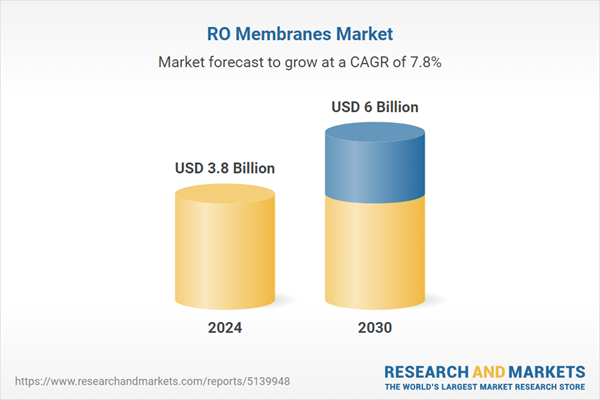The global market for RO Membranes was valued at USD 3.8 Billion in 2024 and is projected to reach USD 6 Billion by 2030, growing at a CAGR of 7.8% from 2024 to 2030. This comprehensive report provides an in-depth analysis of market trends, drivers, and forecasts, helping you make informed business decisions.
Global RO Membranes Market - Key Trends and Drivers Summarized
Exploring the Future of RO Membranes: Innovation, Applications, and Market Dynamics
Reverse Osmosis (RO) Membranes are critical components in water treatment systems, used to remove dissolved salts, contaminants, and impurities from water, making it suitable for various applications such as drinking water, industrial processes, and wastewater treatment. RO membranes function by allowing water molecules to pass through while blocking larger molecules, ions, and particles, effectively desalinating and purifying water. The technology is widely used in municipal water treatment plants, desalination facilities, and industrial settings where high-quality water is essential. As concerns over water scarcity, pollution, and the need for sustainable water management grow, the demand for efficient and reliable RO membranes is increasing. This has positioned RO membranes as a vital technology in addressing global water challenges.How Are Technological Advancements Enhancing RO Membrane Performance?
Technological innovations are playing a pivotal role in enhancing the efficiency, durability, and affordability of RO membranes. The development of Thin-Film Composite (TFC) membranes, for example, has significantly improved salt rejection rates and reduced energy consumption, making RO processes more cost-effective and sustainable. Advances in material science, such as the use of graphene oxide and nanocomposite materials, are further enhancing the permeability and fouling resistance of RO membranes, extending their lifespan and reducing maintenance costs. Additionally, innovations in membrane design, such as the development of spiral-wound and hollow fiber configurations, are optimizing space utilization and flow dynamics, enhancing overall system performance. The integration of smart monitoring and control systems is also enabling real-time performance optimization, ensuring consistent water quality and operational efficiency.What Challenges and Opportunities Are Present in the RO Membranes Market?
The RO membranes market faces challenges such as high operational costs, membrane fouling, and the need for significant energy consumption in the desalination process. Membrane fouling, caused by the accumulation of organic and inorganic materials, can reduce efficiency and increase maintenance costs, posing a challenge for water treatment facilities. Moreover, the high energy requirements of RO processes, particularly in large-scale desalination plants, can be a barrier to widespread adoption in energy-constrained regions. However, these challenges also present opportunities for innovation and growth. The increasing focus on sustainable water management and the rising investments in water treatment infrastructure in emerging markets are driving the demand for advanced RO membranes. The development of energy-efficient and fouling-resistant membranes, as well as hybrid systems that combine RO with other filtration technologies, is creating new growth avenues for market players.What Factors Are Driving the Growth of the RO Membranes Market?
The growth in the RO Membranes market is driven by several factors, including the increasing demand for clean and safe water amid rising concerns over water scarcity and pollution. Technological advancements in membrane materials, design, and energy efficiency are enhancing the performance and cost-effectiveness of RO systems, driving their adoption. The growing emphasis on sustainability and the need for efficient desalination and wastewater treatment solutions are also contributing to market growth. Additionally, the expansion of industrial applications, such as in power generation, pharmaceuticals, and food and beverages, where high-quality water is critical, is boosting the demand for RO membranes. The increasing government investments in water infrastructure development and the adoption of stringent environmental regulations are further propelling the RO membranes market.Report Scope
The report analyzes the RO Membranes market, presented in terms of market value (USD Thousand). The analysis covers the key segments and geographic regions outlined below.Segments
Type (Thin-Film Composite Membranes, Cellulose-Based Membranes); Filter Module (Spiral Wound, Hollow Fiber, Tubular, Plate & Frame); Application (Desalination, RO Purification Systems, Other Applications); End-Use (Water & Wastewater Treatment, Industrial Processing).Geographic Regions/Countries
World; United States; Canada; Japan; China; Europe (France; Germany; Italy; United Kingdom; Spain; Russia; and Rest of Europe); Asia-Pacific (Australia; India; South Korea; and Rest of Asia-Pacific); Latin America (Argentina; Brazil; Mexico; and Rest of Latin America); Middle East (Iran; Israel; Saudi Arabia; United Arab Emirates; and Rest of Middle East); and Africa.Key Insights:
- Market Growth: Understand the significant growth trajectory of the Thin-Film Composite Membranes segment, which is expected to reach $4.3 Billion by 2030 with a CAGR of a 8.1%. The Cellulose-Based Membranes segment is also set to grow at 7.1% CAGR over the analysis period.
- Regional Analysis: Gain insights into the U.S. market, valued at $986.2 Million in 2024, and China, forecasted to grow at an impressive 12.8% CAGR to reach $1.5 Billion by 2030. Discover growth trends in other key regions, including Japan, Canada, Germany, and the Asia-Pacific.
Report Features:
- Comprehensive Market Data: Independent analysis of annual sales and market forecasts in USD from 2024 to 2030.
- In-Depth Regional Analysis: Detailed insights into key markets, including the U.S., China, Japan, Canada, Europe, Asia-Pacific, Latin America, Middle East, and Africa.
- Company Profiles: Coverage of major players such as ACCIONA Agua, Applied Membranes, Inc., Daicel Corporation, Earth Water Group (Aventura), Eurotrol S.p.A. and more.
- Complimentary Updates: Receive free report updates for one year to keep you informed of the latest market developments.
Why You Should Buy This Report:
- Detailed Market Analysis: Access a thorough analysis of the Global RO Membranes Market, covering all major geographic regions and market segments.
- Competitive Insights: Get an overview of the competitive landscape, including the market presence of major players across different geographies.
- Future Trends and Drivers: Understand the key trends and drivers shaping the future of the Global RO Membranes Market.
- Actionable Insights: Benefit from actionable insights that can help you identify new revenue opportunities and make strategic business decisions.
Key Questions Answered:
- How is the Global RO Membranes Market expected to evolve by 2030?
- What are the main drivers and restraints affecting the market?
- Which market segments will grow the most over the forecast period?
- How will market shares for different regions and segments change by 2030?
- Who are the leading players in the market, and what are their prospects?
Some of the 41 major companies featured in this RO Membranes market report include:
- ACCIONA Agua
- Applied Membranes, Inc.
- Daicel Corporation
- Earth Water Group (Aventura)
- Eurotrol S.p.A.
- Hi-Tech Sweet Water Technologies Pvt. Ltd
- SE Tylose GmbH & Co. KG
- Shandong ThFine Chemical Co., Ltd.
- Toray Industries, Inc.
- Toyobo Co., Ltd.
Table of Contents
I. METHODOLOGYII. EXECUTIVE SUMMARY2. FOCUS ON SELECT PLAYERSIII. MARKET ANALYSISCANADAITALYSPAINRUSSIAREST OF EUROPESOUTH KOREAREST OF ASIA-PACIFICARGENTINABRAZILMEXICOREST OF LATIN AMERICAIRANISRAELSAUDI ARABIAUNITED ARAB EMIRATESREST OF MIDDLE EASTIV. COMPETITION
1. MARKET OVERVIEW
3. MARKET TRENDS & DRIVERS
4. GLOBAL MARKET PERSPECTIVE
UNITED STATES
JAPAN
CHINA
EUROPE
FRANCE
GERMANY
UNITED KINGDOM
ASIA-PACIFIC
AUSTRALIA
INDIA
LATIN AMERICA
MIDDLE EAST
AFRICA
Companies Mentioned (Partial List)
A selection of companies mentioned in this report includes, but is not limited to:
- ACCIONA Agua
- Applied Membranes, Inc.
- Daicel Corporation
- Earth Water Group (Aventura)
- Eurotrol S.p.A.
- Hi-Tech Sweet Water Technologies Pvt. Ltd
- SE Tylose GmbH & Co. KG
- Shandong ThFine Chemical Co., Ltd.
- Toray Industries, Inc.
- Toyobo Co., Ltd.
Table Information
| Report Attribute | Details |
|---|---|
| No. of Pages | 294 |
| Published | April 2025 |
| Forecast Period | 2024 - 2030 |
| Estimated Market Value ( USD | $ 3.8 Billion |
| Forecasted Market Value ( USD | $ 6 Billion |
| Compound Annual Growth Rate | 7.8% |
| Regions Covered | Global |









